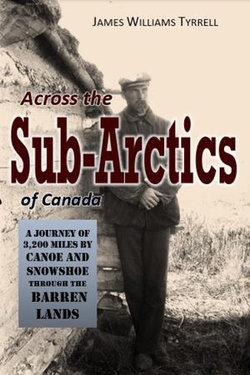"As a record of adventure, of imminent peril and hair-breadth escapes, of hunting polar bears, and taking a winter tramp of a thousand miles, we know no narrative of more absorbing character." -Methodist Magazine, 1898
"Decidedly well-told story." Canadian Bookseller, 1898
"Interesting from many points of view."-Educational Monthly of Canada, 1898
The Brothers Tyrrell have the honour of having made the most extensive tour through previously unexplored territory ever undertaken in Canada.
In his 1897 book "Across the Sub-Arctics of Canada" James Williams Tyrrell writes modestly of a trip of 3,200 miles by canoe and snow-shoe over a totally unexplored and unmapped country. The expedition, full of hardships and narrow escapes, was under the direction of the author's brother, Mr. J. Burr Tyrrell, of the Canadian Government Geological Survey. They took a route unknown even to the Indians, from Athabasca Lake to the Dubawnt River, Chesterfield Inlet, and down the west coast of Hudson Bay.
Our maps to-day are indebted to this expedition for their topography of this region. The gap which had existed on maps between Lakes Athabasca and Doobaunt was filled up.
Tyrrell's account leads through wonderful lakes and rivers hitherto unvisited by white men, with thrilling adventures in running unknown and perilous rapids; it tells of the lonely far north outposts of the Hudson's Bay Company; introduces us to the Indian and Eskimo natives of that terra incognita, and makes us acquainted with the hardy voyageurs and marvellously skilful canoe-men; it furnishes hunting adventure with bear, musk ox, caribou, reindeer, bear, and wolves.
Tyrrell gives a very interesting account of the Eskimo whom he met in his northern journey. They impress us as a honest, brave and ingenious people. Their struggle for existence is one continuous battle with frost and snow and arctic seas. The chapters on these ingenious people, their character and customs, are among the most interesting in the volume.
In discussing Eskimo bear-hunting skills, Tyrrell writes:
"Polar bear hunting is an extremely dangerous and exciting sport. An Eskimo rarely ever cares to tackle a bear single-handed, but two men, armed with lances, do not hesitate to attack this monarch of the north. Two men, armed only with lances, approach it from opposite sides at the same time. Then, as they close upon it, and the bear charges either man, the other rushes forward with his lance. It requires cool heads and steady nerves to be able to cope successfully with a polar in this way, but both of these characteristics the Eskimos possess in a marked degree."
We get also a picturesque and rather vivid glimpse of the Eskimo household with its strange code of rules, and its women whose duty it is to chew daily the delectable foot-gear of the whole family.
In describing a polar bear attack on their party, Tyrrell writes:
"The bear, springing to his feet, made straight for Louis, who met his charge with a slug and brought him to his knees. He was up in an instant, though, and followed the Indian, who had taken to the ice, thinking that in a conflict he would there have the advantage. But in this he found he was mistaken. The bear was quickly overtaking him, being at home on the ice. As Louis made for the shore the bear regained his feet, and with blood streaming from his wounds, and a roar of fury, made one more desperate charge. He was now within a few feet of Louis...."
The trip of these young Canadians shows them capable of as high heroism as the better-known explorers, and before their journey's end their mettle was fully tested.



Share This eBook: